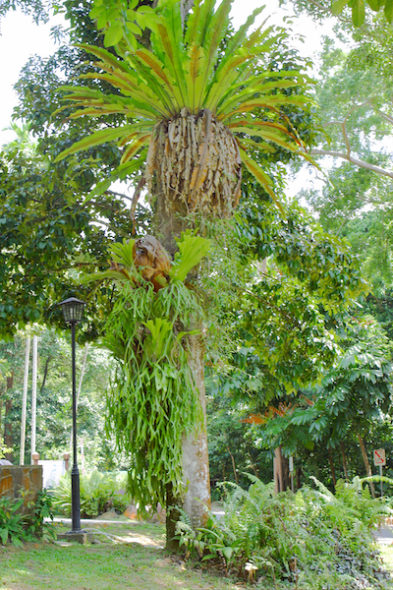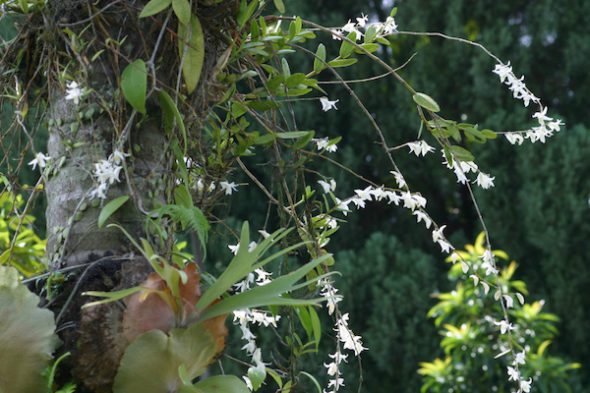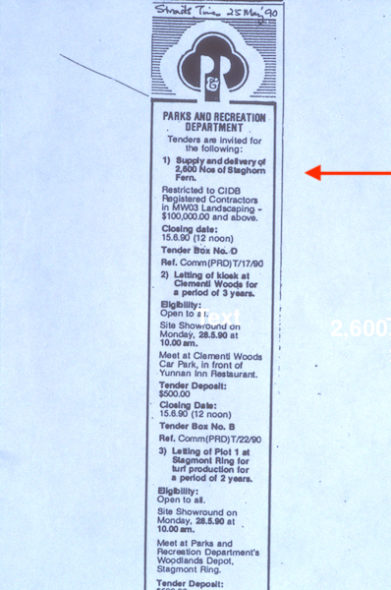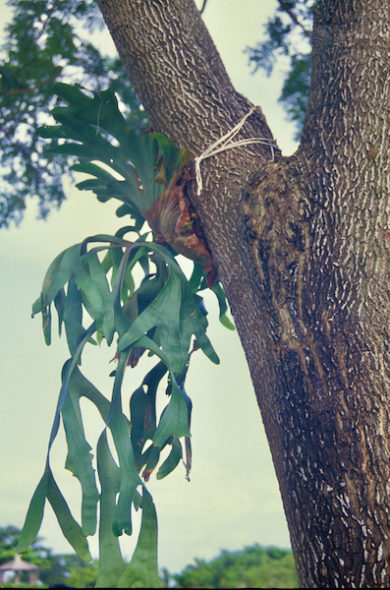The story of ferns and orchids growing on the trunks and branches of our wayside trees is a sort of love-hate relationship.

Staghorn Ferns growing along the trunk of a jungle tree at the southern boundary of the Bukit Timah Nature Reserve.
During the 1960s many of our wayside trees were covered with Staghorn Ferns (Platycerium coronarium). There was a tree at the southern boundary of the Bukit Timah Nature Reserve that had a series of these ferns along its trunk (above). These ferns are epiphytes, that is, plants that grow on trees. They depend on the trees for support, collecting falling leaves with their basket fronds. Many of our wayside trees were similarly covered with these ferns. Sometimes there was also a Bird’s Nest Fern (Asplenium nidus) (below) and even Pigeon Orchids (Dendrobium crumenarum) growing together (below).

A tree with a large Staghorn Fern and a Bird’s Nest Fern above it outside the Bukit Timah Nature Reserve.

A tree with a Staghorn Fern together with a bunch of Pigeon Orchids.
Around the first half of 1980s, team of workers were seen tearing down these magnificent ferns and pigeon orchids from the trunks and branches of wayside trees. This was because there was a belief that these epiphytes retain water around their roots and contribute to the rotting of the branches they were attached to. It was also believed that the water could lead to mosquito breeding.

Letter to The Straits Times of 9th November 1985 pleading government to stop removing epiphytes from wayside trees.
Members of the then Malayan Nature Society (Singapore Branch) were alarmed and wrote to The Straits Times to plead to the authorities to stop the removal of these plants from the wayside trees (above). There was no response and the denuding of wayside trees of these epiphytes continued (below).

A tree at the Bukit Timah campus with its trunk and branches “cleanly scrubbed” and unsightly looking.
On morning on 25th May 1990, I was amused to notice in The Straits Times an advertisement by the Parks and Recreation Department to purchase 2,600 pieces of Staghorn Ferns (below). These ferns were commonly found growing from the branches of rubber trees in Malaysia, but I was doubtful if such a large number of Staghorn Ferns could easily be found. In due course, quite a number were acquired and these were gingerly tied around tree branches all over Singapore (below).

Advertisement in The Straits Times to buy 2,600 pieces of Staghorn Ferns.

A Rain Tree (Samanea saman) with a large staghorn fern tied to its branch at Pasir Ris Park.
Then there was the case of the Pigeon Orchids (Dendrobium crumenatum). These were similarly removed earlier with the ferns. No doubt these orchids were subsequently bought and many of them were similarly tied to the branches of trees in a campaign to make Singapore a fragrant city.

Press cutting – The Straits Times, 7th February 1990.
By early 1990 workers were seen busy replacing the Pigeon Orchids in many areas in the city. A total of 500 trees had their branches adorned with these orchids, tied firmly with rubber tubes. These orchids are attractive when in flowers, usually triggered by temperature changes, like after a dry spell followed by rain. The air will then be filled with their sweet fragrance all over Singapore, which will then be turned into a fragrant city.
Wee Yeow Chin
15th February 2023








